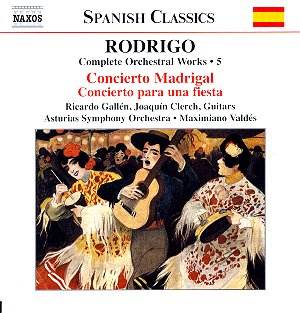A late-comer so far as this series was concerned, I
have already sung the praises of volumes 3
and 4.
This volume follows very hot on their heels.
Many people recognise the Concierto de Aranjuez
- the majority without being able to name the work or the composer
such is its ubiquitous presence. In this disc we look beyond Aranjuez
and the Fantasia para un Gentilhombre (a coupling beloved of
many - eminently by Narciso Yepes on DG). The guitar concertos first
came to my attention when I bought a bargain 2LP collection of the Rodrigo
guitar works (Philips) in 1979. The Romero family were the mainstays
in that case. Here the changes are rung.
The Fiesta has charm: low key, relaxed,
supple and undemanding. The premiere took place at Ridgelea Country
Club, Fort Worth Texas on 6 March 1983 to mark the coming out of Alden
and Lauri McKay. The soloist was Pepe Romero. It was written to a commission
by the girls' parents. Inspiration gutters in the finale so we must
keep our hopes within limited bounds.
While Fiesta is in the standard three movements,
the Concierto Madrigal (which is for two guitars) is in
ten episodes ranging from 1.40 to 6.03. Most are less than three minutes
duration. The work is helped along by the ear-catching antiphonal effects
of the two guitars. The engineers make good use of this. The movements
range far and wide: snappy (Fanfare), inventive and plangently
reflective (Madrigal), mordantly edgy (Entrada), nervy-ominous
(Girardilla), deliciously innocent raindrop evocations (Pastoral
and Arietta) and scathingly percussive Stravinskian (Zapateado).
The final Caccia returns to the madrigal around which the concerto
is built O felici occhi miei. This work is of very high quality.
It was written for Alexandre Lagoya and Ida Presti but premiered by
Ángel and Pepe Romero with the Los Angeles Phil conducted by
Rafael Frühbeck de Burgos on 30 July 1967 at the Hollywood Bowl.
These works are most attractively performed, recorded
and balanced. They are despatched with style by all concerned though
the orchestra seems less secure than Max Bragado-Darman's Castille y
Léon orchestra as used in volumes 3 and 4. Nothing to deter unduly
and, given the imaginative qualities of the Madrigal and of the two
soloists, a firm recommendation is in order.
Rob Barnett
